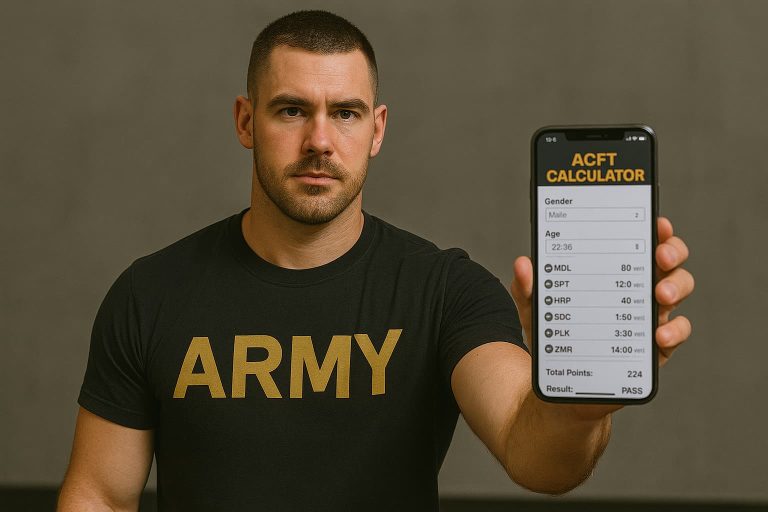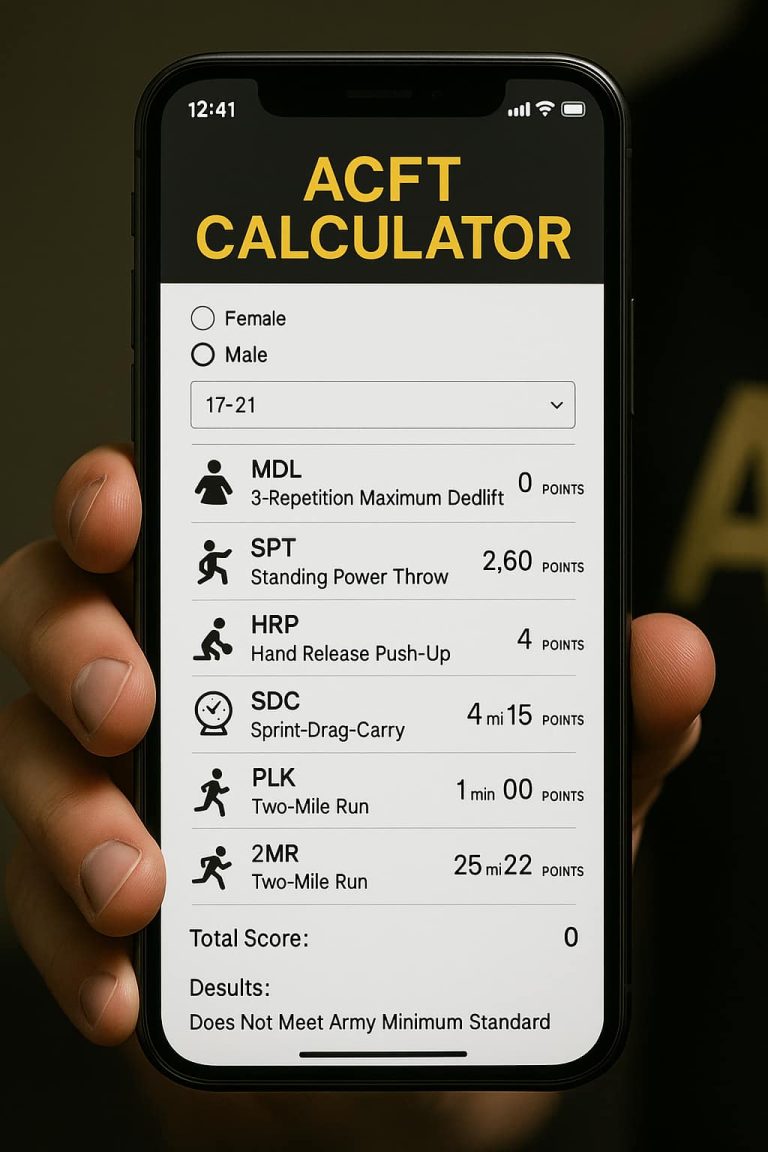7 Practical Tips to Pass the ACFT Test on Your First Try
I’ll be honest with you — when I first heard about the ACFT, I was nervous as hell. The thought of failing my first attempt and having to retake it was eating me alive.
But I’m happy to say I not only passed on my first try, I scored 545 points total, which completely blew my own expectations out of the water.
Looking back, there were seven key things that made all the difference between just hoping for the best and actually crushing it.
Top 7 Practical Tips to Pass the ACFT Test

If you’re preparing for your first ACFT, these tips will save you time, stress, and probably some embarrassment too.
1. Build a Realistic Training Schedule (And Actually Stick to It)
Here’s where most people mess up — they either go way too hard right out of the gate or they don’t have any structure at all. I learned this lesson the hard way after burning myself out in week two of training.
What worked for me:
- 3-4 training days per week (never more than that)
- Focus on 2-3 ACFT events per session
- Mix strength days with conditioning days
- Always take at least one full rest day between intense sessions
I started 12 weeks out from my test date, which gave me plenty of time to build up gradually without rushing. Don’t try to cram everything into 4-6 weeks — you’ll either get injured or burn out mentally.
Pro tip: I used the ACFT Calculator every week to track my progress. Seeing my scores improve from 425 to 545 over those 12 weeks kept me motivated when the workouts got tough.
2. Identify Your Weak Points Early (And Attack Them First)
This might be the most important tip on this list. I wasted the first month of training doing what I was already good at instead of focusing on my weakest events.
Here’s how to figure out your weak spots:
- Take a baseline practice test in week 1
- Plug your results into the ACFT Calculator to see your scores
- Identify which events are dragging down your total
- Spend 60% of your training time on those weak areas
For me, it was the Standing Power Throw and Sprint-Drag-Carry. I was naturally good at running and push-ups, but those two events were killing my overall score.
Once I shifted my focus and started spending most of my gym time on explosive power and anaerobic conditioning, everything changed.
Don’t make my mistake — attack your weaknesses from day one.
3. Master the Form Before You Worry About Numbers
I can’t stress this enough: perfect practice makes perfect performance. I spent the first two weeks just learning proper form for each event without worrying about my scores at all.
Events where form makes or breaks you:
- Hand-Release Push-Ups: Learn to completely lift your hands and chest off the ground
- Deadlift: Master the hip hinge movement with lighter weight first
- Standing Power Throw: Practice the squat-to-explosive-throw motion
- Plank: Find the proper alignment that you can maintain for 3+ minutes
My approach: I watched YouTube videos, practiced with mirrors, and even asked a buddy to film me so I could see my mistakes. Bad form not only gets you fewer reps or less weight — it can get you a zero on the entire event.
Once you nail the form, then you can start pushing the intensity and tracking your score improvements with the calculator.
4. Fuel Your Body Like Your Career Depends on It (Because It Does)
Nutrition and hydration made a bigger difference than I expected. I’m not talking about some crazy diet — just basic stuff that actually works.
My daily nutrition game plan:
- Breakfast: Oatmeal with banana and peanut butter for sustained energy
- Pre-workout: Light snack 30-60 minutes before training
- Post-workout: Protein shake within 30 minutes
- Throughout the day: Constant hydration (clear or light yellow urine)
Test day nutrition: I ate my normal breakfast 2-3 hours before the test. Nothing new, nothing fancy. The last thing you want is to discover you don’t handle something well on test day.
I also cut back on alcohol and junk food during my 12-week prep. Not completely — I’m not a monk — but I was way more conscious about fueling my training properly.
5. Prioritize Recovery Like It’s Part of Your Training
This was a game-changer that I almost learned too late. After week 6, I was feeling beat up and my scores were actually getting worse. That’s when I realized I wasn’t recovering properly between sessions.
My recovery protocol:
- Sleep: 7-8 hours minimum every night
- Active recovery: Light walking or stretching on rest days
- Foam rolling: 10-15 minutes after every workout
- Listen to your body: If you feel like garbage, take an extra rest day
I know it sounds basic, but your body adapts and gets stronger during recovery, not during the workout itself. I started seeing better score improvements when I took recovery seriously.
The calculator helped me track this too — I could see that my scores were actually higher after taking proper rest days versus pushing through when I was tired.
6. Practice Time Management and Mental Prep
The ACFT isn’t just physically demanding — it’s mentally challenging too. Six events back-to-back with minimal rest will test your focus and mental toughness.
What I practiced:
- Transitions between events: Know exactly what’s coming next
- Breathing techniques: Simple box breathing (4-4-4-4 count) between events
- Positive self-talk: Specific phrases for when things get tough
- Visualization: Mental rehearsal of each event going perfectly
Test day strategy: I showed up 30 minutes early, did a light warm-up, and ran through my mental checklist. Having a routine helped calm my nerves and made everything feel familiar.
I also used the calculator the night before to remind myself of my goal scores for each event. Knowing exactly what numbers I needed took away the guesswork and stress.
7. Stay Consistent and Find an Accountability System
Consistency beats intensity every single time. I’d rather see someone train moderately for 12 weeks straight than go all-out for 4 weeks and then burn out.
My accountability system:
- Training partner: Found a buddy with the same test date
- Weekly check-ins: Measured progress every Saturday morning
- Score tracking: Used the ACFT Calculator to document improvements
- Small rewards: Celebrated hitting weekly goals (favorite meal, movie night)
Having someone else expecting me to show up made all the difference on days when motivation was low. And seeing my scores improve week by week in the calculator kept me focused on the long-term goal.
Weekly routine: Every Saturday, we’d do a practice session, plug our numbers into the calculator, and plan the following week’s training based on what we needed to improve.
Putting It All Together
Look, I’m not some fitness freak or natural athlete. I’m just a regular soldier who took the preparation seriously and followed a solid plan. The ACFT is absolutely passable on your first try if you approach it smart.
The biggest mistake I see people make is overthinking it or trying to cram everything into the last few weeks. Start early, be consistent, focus on your weak points, and track your progress regularly.
My final recommendation: Make the ACFT Calculator your best friend throughout training. I probably checked my scores 2-3 times per week, and it kept me motivated and focused on the events that mattered most for my total score.
Visit https://armyacftcalc.com and start tracking your baseline today. Set specific, measurable goals for each event, and check your progress regularly. The calculator helped me turn abstract training into concrete, achievable targets.
You’ve Got This
The ACFT might seem intimidating now, but it’s just six exercises that you can absolutely master with the right preparation.
I went from being nervous about failing to scoring 545 points because I had a plan and stuck to it.
If I can do it, you can too – just stay consistent, focus on your weak points, and make that calculator your best friend for tracking progress.
Trust the process, put in the work, and you’ll surprise yourself with what you can achieve.
Now stop reading and get started – your first ACFT victory is waiting for you!





